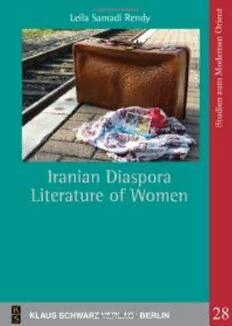
Iranian Diaspora Literature of Women PDF
Preview Iranian Diaspora Literature of Women
Leila Samadi Rendy Iranian Diaspora Literature of Women Studien zum Modernen Orient herausgegeben von Gerd Winkelhane Studien zum Modernen Orient 28 Leila Samadi Rendy Iranian Diaspora Literature of Women Bibliographic Information of Deutsche Nationalbibliothek Deutsche Nationalbibliothek registers this publication in the Deutsche Nationalbibliografie; detailed bibliographical data can be accessed at http://dnb.ddb.de. Cover pic by L. Samadi Rendy www.klaus-schwarz-verlag.com All rights reserved. No part of this book may be reprinted or reproduced or utilised in any form or by any electronic, mechanical, or other means, now known or hereafter invented, including photocopying and recording, or in any information storage or retrieval system, without permission in writing from the publishers. © 2017 by Klaus Schwarz Verlag GmbH Berlin First edition Producer: J2P Berlin Printed in Germany on chlorine-free bleached paper ISBN 978-3-87997-457-3 For My Father Abstract Some years before and after the Islamic revolution in Iran in 1979, a huge number of Iranians migrated to western countries due to social and political problems. There is a significant body of literary and auto- biographical works by Iranian writers in the Diaspora during the last 50 years. The early works are mostly social and political, as writing about the private lives has been taboo, even in the diaspora. These lit- erary writings has been analysed in Western academia to get a closer view of the political and social conditions in Iran before and after the Islamic revolution. However, in the last two decades, more literary and autobiographical works have been concerned with the private aspect of the lives of the characters in the Diaspora and the (trans)formation of their identity and the linguistic and cultural hybridity. This hybrid- ity and the identity issues become more significant in the works of wo- men writers, as they are doubly marginalised as immigrants in the host land and second sex within patriarchy. There have been only a few critical works on the recent literary and autobiographical works of Ira- nian female writers in the Diaspora. This work examines the relation- ship between space, bilingualism, and writing, and female characters’ identity formation in the late literary productions of Iranian women in the Diaspora, using post-colonial and postmodern theories of bilin- gualism, space, autobiography and gender. In this research, the works of poetry and prose published in the an- thology Let Me Tell You Where I’ve Been: New Writing by Women of the Iranian Diaspora, edited by Persis M. Karim (2006), and the full text of four memoirs, extracts from which are included in this work, are chosen for the case study. The first theme of this research is the significance of space and dis- placement in the selected literary works. Here the private space of home and the public spaces of city and homeland, and their significan- ce for the gendered identity of the female characters, has been exami- ned using post-colonial and post-modern theories. The second focus of this research is bilingualism and its role in the formation of the gendered identity of the female characters and narrat- ors of the selected literary works. The generation and the community to which the subjects are connected shape their identity and invest- ments in language and cultural capital. This leads to the creation of a personal English among the female characters and the use of English to refer to specific subjects requiring the freedom associated with this language. The last theme of this research is the role of writing in identity for- mation of the female characters and the characteristics of the selected autobiographies and literary works of Iranian women in the diaspora. As the narrators in some texts claim, they write to recover from trau- mas and as a defense method against shame feelings. Besides, the sub- ject searches for her ‘self’ in the process of writing. Stories of mothers and motherhood as complements of the narratives of self, and expres- sion of personal theories to avoid inferiorization are of other themes of these works. TABLE OF CONTENTS Acknowledgements CHAPTER ONE: INTRODUCTION....................................................................13 Introduction and Case Study................................................................................13 Research Questions.................................................................................................17 Background of the Study and Review of Literature........................................18 Methods and Outline..............................................................................................21 CHAPTER TWO: SPACE AND GENDER..........................................................33 Home and Gender...................................................................................................34 City and Gender......................................................................................................43 a. Gendered Identity in Iranian Cities.........................................................44 b. Western Cities and Gendered Identity....................................................56 Homeland and Gender...........................................................................................65 Conclusion................................................................................................................80 CHAPTER THREE: BILINGUALISM AND GENDER......................................82 Second Language Acquisition and Gender.......................................................83 Generations...............................................................................................................84 a. First Generation ...........................................................................................85 b. Second Generation.......................................................................................89 Writing in the Language of the Other................................................................97 a. Creation of Personal English.....................................................................98 b. Using English as the Language of Taboos and Secrets.....................101 Conclusion .............................................................................................................104 CHAPTER FOUR: WRITING AND GENDER.................................................106 Iranian Women and Writing...............................................................................106 Autobiographical Works of the Second Generation of Iranian Female Writers in the Diaspora ...................................................................109 a. Victim Stories..............................................................................................110 b. Narratives of Shame/Guilt.......................................................................115 c. The Quest for Identity..............................................................................120 d. Narratives about Mother Figures...........................................................126 e. Expressing Personal Social and Political Views.................................133 Conclusion .............................................................................................................137 CHAPTER FIVE: CONCLUSION.......................................................................138 Summing Up...........................................................................................................138 Findings...................................................................................................................140 Appendix I: Selected Bibliography of the Literary Works of Iranian Women in the Diaspora..............................................................145 Appendix II: Short Biographies of the Authors.............................................148 Works Cited............................................................................................................163 Index.........................................................................................................................176
